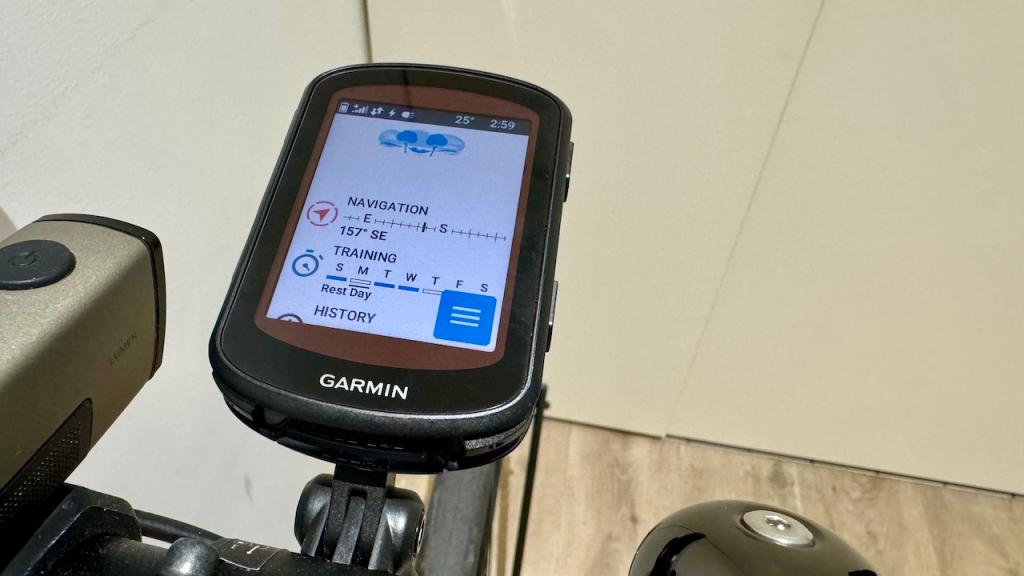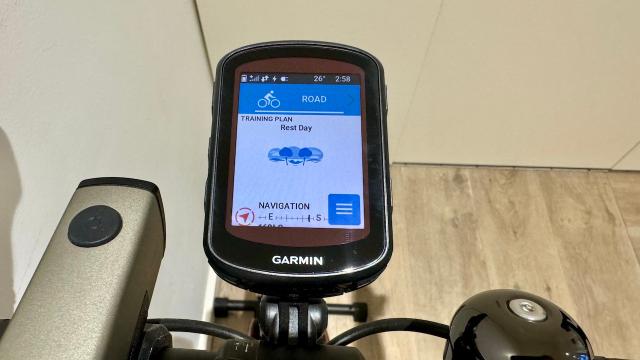For years, I have insisted that bike computers are a waste of money. Why would you need one when you could just use a Quad Lock to attach your phone to your handlebars? But, as with all fancy bike things, I have now realised the error of my ways and am hopelessly devoted to my Garmin Edge 840 Solar. At $879, it is a tough ask when a Quad Lock is just $49.95 for the phone you already have. However, if you’re putting in a lot of hours on your bike in sunny places, I think it’s worth it.
What is the Garmin Edge 840 Solar?
The Garmin Edge 840 Solar is a bike computer with a 2.6″ screen. What sets it apart from other bike computers is that you can also charge it with solar power while you ride. You won’t be able to fully charge it with just the sun, but it’ll give you some extra time if you’ve gone bike packing or forgot to charge it for a couple of rides (as I often do). The screen is smaller than the similarly-sized 1040 because of the bezel, and the red parts of the bezel are where the solar panel is.
I got the Edge 840 Solar in autumn and rode it around Melbourne on overcast days and still always managed to pull some charge. It is a more useful feature in summer, though. Riding in full sun on the weekend for two hours only used 5% of the battery.
Is that worth the extra $130 over the regular 840 to you? Only you can know that. But I’m glad to have it.
At 88.9g, it’s neither the heaviest nor lightest bike computer out there, but it is on the lighter side.
One bonus it has over its predecessors is that it has USB-C instead of Micro-USB. Half of my cycling gear still uses Micro-USB, this is an extra welcome touch.
Is the Garmin Edge 840 Solar good even if you’re not a pro cyclist?

One of the things that held me back from embracing bike computers earlier was that I didn’t think I rode enough to need or deserve one. During lockdown and when I worked at an office I would be riding for more than a dozen hours a week. But, now that I purely work from home and still haven’t found anyone else to ride with regularly, I’m only riding around 6 hours a week, despite wishing I could ride more. I’m not going to be winning the Tour de France any time soon, and I still don’t have a full handle on the depth of all the metrics Reddit says I should care about.
But, while I might not get as much out of a bike computer as a pro would, I’ve discovered a lot of features which have really enhanced my rides.
The main one is the Garmin GPS map that’s built in. It knows all the bike paths and trails. You can upload routes that you want to take, or just ride and see what you find. I haven’t been opening the map much, but on the weekend I decided to just ride and follow a path I’d just seen the entrance to. As I was riding with the Edge 840 Solar open to the power meter metrics screen, the computer picked up with track I was on, and gave me directions to stay on the path, and warned me of sharp turns 100m ahead. It really gave me confidence to keep riding further on this strange path, and told me when I needed to slow down, because there were no signs on the path itself.
I also really like that it tells me when I’m starting a climb, showing me the grade and distance of the hill so I can properly use my energy and strength to get up it. Turns out there are a lot of sneaky hills that I hadn’t before realised were hills and previously just taken as a sign that I was tired and it was time to head back. It’s almost like having a co-pilot in a rally driving game or something.
I don’t ride with a separate heart rate sensor, because I have my Apple Watch, and I’m disappointed I can’t import my heart rate data into the 840, but I do like still being able to do interval training now that I have a power meter.
And that’s the other good thing about the 840. In the Garmin Connect app you can come up with training plans. I’m currently disappointing the training plan I came up with to get to my distance goal, because work keeps getting in the way of when Garmin wants to be riding, but I am enjoying the training rides I do go on as I come to trust it more.
Another thing I really like is that it has both buttons and a touch screen. I wear gloves when I ride (I learned that lesson in a painful crash a few years ago), and so being able to press the buttons to start and stop, or change settings when I’m stopped at the lights, is really handy.
I do still ride with my phone on a Quad Lock mount, just because I find it easier to have maps open on my phone for directions and metrics on the Edge 840 Solar. But I can see that changing as I get more comfortable with the Garmin.
The crash detection on the Garmin is very good, too. I had a crash a few weeks back that wasn’t picked up on my Apple Watch because I landed on the wrong side, but the Edge 840 picked it up, let out a loud sound, and counted down to notifying my emergency contacts. That’s good for extra peace of mind.
Finally, the GPS accuracy is excellent. On par with my Apple Watch Ultra 2, and well beyond the accuracy of my iPhone 15 Pro Max. The multi-band GNSS makes a noticeable difference to the accuracy
What’s not good about the Garmin Edge 840 Solar?

The screen is just a touch small to easily read a map on at a glance.
I also find the way it presents information when you’re using a Varia Radar accessory to be a bit vague and irritating. Both are excellent devices, but the constant beeping becomes unhelpful.
Garmin Edge 840 Solar Verdict
This is the bike computer for pros and people who want all the good bike toys. It presents information well on the whole, and the solar panel adds a little extra juice if you go out for a while.
Whether you’d prefer the solar panel of the Edge 840 Solar or the larger screen of the 1040 is up to you. I think most people would probably benefit from the larger screen more, unless they’re frequently going for rides longer than 32 hours without access to power.
At $879 it is very expensive, particularly when the version without solar costs $749. But I’m really impressed by it. As my first proper bike computer, I have been spoiled and never want to go back.
